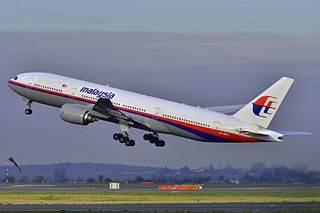Iridium Communications Inc. is a publicly traded American company headquartered in McLean, Virginia, United States. Iridium operates the Iridium satellite constellation, a system of 75 satellites: 66 are active satellites and the remaining nine function as in-orbit spares. Iridium Satellites are used for worldwide voice and data communication from handheld satellite phones, satellite messenger communication devices and integrated transceivers, as well as for two-way satellite messaging service from supported conventional mobile phones. The nearly polar orbit and communication between satellites via inter-satellite links provide global service availability.
Air-ground radiotelephone service is a system which allows voice calls and other communication services to be made from an aircraft to either a satellite or land based network. The service operates via a transceiver mounted in the aircraft on designated frequencies. In the US these frequencies have been allocated by the Federal Communications Commission.
Connexion by Boeing (CBB) was an in-flight online internet connectivity service from Boeing. This service allowed travellers to access a high-speed internet connection while on board a plane in flight through a wired Ethernet or a wireless 802.11 Wi-Fi connection. Connexion by Boeing was formed as a separate business unit of The Boeing Company. Major development on the service commenced with a partnership agreement between United Airlines, Delta Air Lines, and American Airlines on June 13, 2001. Lufthansa joined the partnership as the International launch customer on June 17, 2001. United, Delta, and American subsequently withdrew from the partnership after the 9/11 terrorist attacks due to the severe drop in airline travel that occurred after the attacks.
Aeronautical Radio, Incorporated (ARINC), established in 1929, was a major provider of transport communications and systems engineering solutions for eight industries: aviation, airports, defense, government, healthcare, networks, security, and transportation. ARINC had installed computer data networks in police cars and railroad cars and also maintains the standards for line-replaceable units.
Kingfisher Airlines Limited was an airline group based in India. It was established in 2003 and started its commercial operations in 2005. Through its parent company United Breweries Group, it had a 50% stake in low-cost carrier Kingfisher Red.

In aviation, ACARS is a digital datalink system for transmission of short messages between aircraft and ground stations via airband radio or satellite. The protocol was designed by ARINC and deployed in 1978, using the Telex format. More ACARS radio stations were added subsequently by SITA.

In-flight entertainment (IFE) refers to the entertainment available to aircraft passengers during a flight. In 1936, the airship Hindenburg offered passengers a piano, lounge, dining room, smoking room, and bar during the 2+1⁄2-day flight between Europe and America. After World War II, food and drink services were offered, and movies were projected onto big screens viewable by all passengers on long flights. In 1985 the first personal audio player became available for purchase, and noise cancelling headphones were introduced in 1989. During the 1990s, the demand for better IFE was a major factor in the design of aircraft cabins. Before then, entertainment came via audio headphone sockets and airline-provided headphones providing music of various genres and the soundtrack of projected movies. Now, in most aircraft, personal IFE display screens are available at most seats, offering entertainment and flight information such as a moving map, speed, and altitude. The advent of small entertainment and communication devices also allows passengers to also use their own devices, subject to regulations to prevent them interfering with aircraft equipment.
The Future Air Navigation System (FANS) is an avionics system which provides direct data link communication between the pilot and the air traffic controller. The communications include air traffic control clearances, pilot requests and position reporting. In the FANS-B equipped Airbus A320 family aircraft, an Air Traffic Services Unit (ATSU) and a VHF Data Link radio (VDR3) in the avionics rack and two data link control and display units (DCDUs) in the cockpit enable the flight crew to read and answer the controller–pilot data link communications (CPDLC) messages received from the ground.

Panasonic Avionics Corporation (PAC) designs, engineers, manufactures, sells and installs customized in-flight entertainment and communications devices to airlines worldwide. It is a subsidiary of Panasonic Corporation of North America, the principal North American subsidiary of Panasonic Corporation, and operates under the umbrella of the Panasonic Connect group. Panasonic Avionics Corporation was founded in 1979 as Matsushita Avionics Systems Corporation and changed its name in 2005. It is headquartered in Irvine, California and has major business functions in Bothell, WA.

Viasat is an American communications company based in Carlsbad, California, with additional operations across the United States and worldwide. Viasat is a provider of high-speed satellite broadband services and secure networking systems covering military and commercial markets.

Inmarsat is a British satellite telecommunications company, offering global mobile services. It provides telephone and data services to users worldwide, via portable or mobile terminals which communicate with ground stations through fifteen geostationary telecommunications satellites.
SITAONAIR is a company that enables airline passengers to use their smart devices including mobile phones and laptops for calls, text messaging, emails and Internet browsing.

Gogo Business Aviation is a division of Gogo Inflight Internet is a provider of in-flight broadband Internet service and other connectivity services for business aircraft. It is headquartered in Broomfield, CO.

Gogo Inc. is an American provider of in-flight broadband Internet service and other connectivity services for business aircraft, headquartered in Broomfield, Colorado. Through its Gogo LLC subsidiary, Gogo previously provided in-flight WiFi to 17 airlines until the Commercial Air business was sold to Intelsat for $400 million in December 2020. According to Gogo, over 2,500 commercial aircraft and 6,600 business aircraft have been equipped with its onboard Wi-Fi services. The company is the developer of 2Ku, new in-flight satellite-based Wi-Fi technology rolled out in 2015.
AeroMobile Communications Limited is a registered mobile network operator for the aviation industry and is based in the UK. It provides technology and services that allow the safe use of passengers' own mobile phones while inflight. A subsidiary of Panasonic Avionics Corporation its services are often installed alongside Panasonic's Wi-Fi network and can be installed either at the point of aircraft manufacture or retro-fitted across both Airbus and Boeing aircraft. Panasonic Avionic's Wi-Fi network and AeroMobile's mobile phone network are complimentary services and provide passengers with a choice of inflight connectivity options.
FlyNet is an onboard communication service for Lufthansa.
Eurostar is a satellite bus made by Airbus Defence and Space which has been used for a series of spacecraft providing telecommunications services in geosynchronous orbit (GEO). More than 70 Eurostar satellites have been ordered to date, of which more than 55 have been successfully launched since October 1990 and have proven highly reliable in operational service. In December 2013, the Eurostar satellites accumulated 500 years of successful operations in orbit. The Eurostar spacecraft series is designed for a variety of telecommunications needs including fixed services and broadcast, mobile services, broadband and secured communications.

The analysis of communications between Malaysia Airlines Flight 370 and Inmarsat's satellite telecommunication network provide the primary source of information about Flight 370's location and possible in-flight events after it disappeared from military radar coverage at 02:22 Malaysia Standard Time (MYT) on 8 March 2014, one hour after communication with air traffic control ended and the aircraft departed from its planned flight path while over the South China Sea.
Inmarsat-6 F1 is a communications satellite to be operated by the British satellite operator Inmarsat and designed and manufactured by Airbus Defence and Space on the Eurostar 3000EOR satellite bus. Part of the Inmarsat-6 satellite fleet, it will be Inmarsat's first dual-payload satellite, with capabilities in both L-band (ELERA) and Ka-band. Claimed to be the largest and most sophisticated commercial telecommunications satellite ever launched, as the first of two such vehicles, it was placed into supersynchronous transfer orbit on 22 December 2021.
Honeywell's JetWave is a piece of satellite communications hardware produced by Honeywell that enables global in-flight internet connectivity. Its connectivity is provided using Inmarsat’s GX Aviation network. The JetWave platform is used in business and general aviation, as well as defense and commercial airline users.